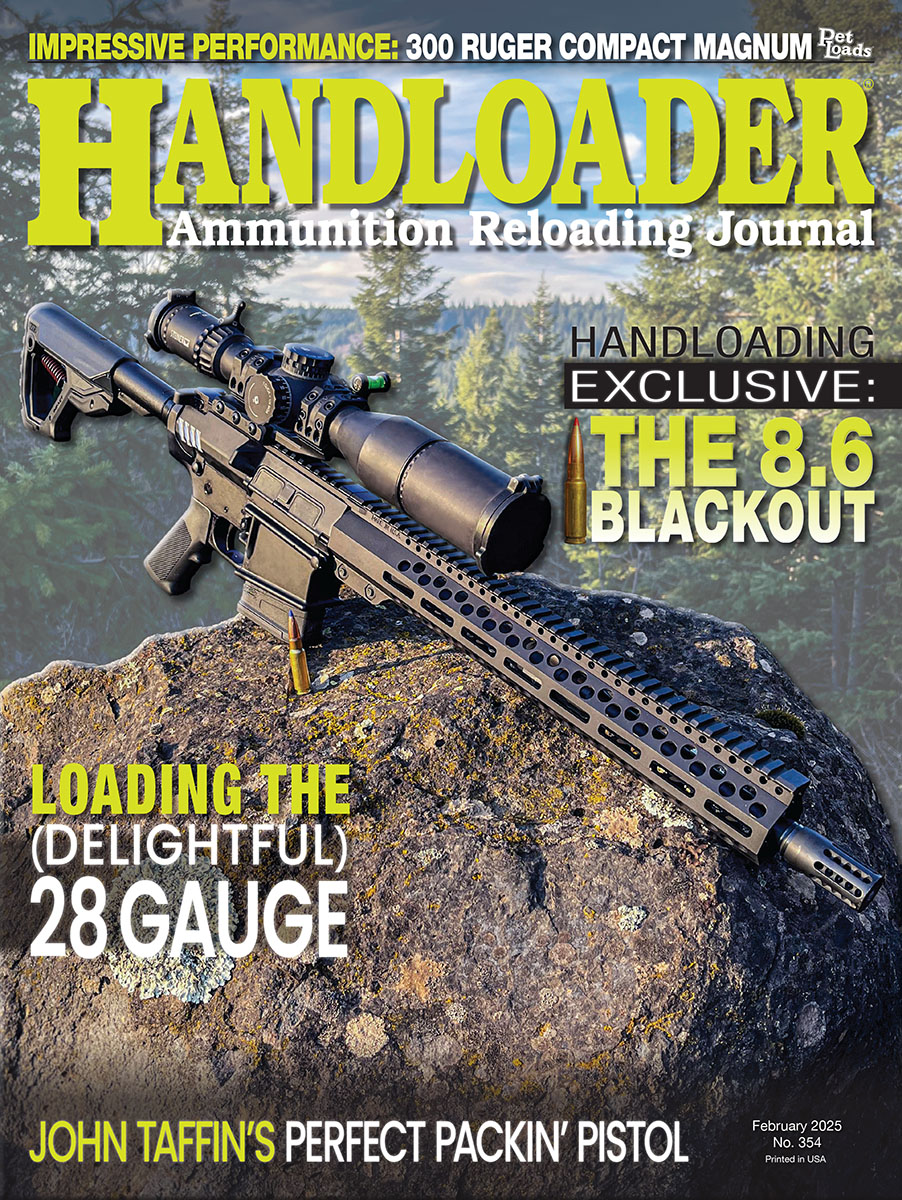
Browning’s X-Bolt 2 Speed bolt action rifle holds a redesigned receiver and bolt and a lightweight, fluted 24-inch barrel with radial muzzle brake on nonstandard M13x0.75 threads. The 1:7.5 rifling twist easily stabilized all test bullets.
The 6.8 Western was created in 2021 through a collaboration between Winchester Repeating Arms Company and Browning Arms Company. The goal was to produce a long-range cartridge introducing magnum ballistics combined with tolerable recoil ideal for Western big-game hunting and long-range target shooting. The 6.8 Western accomplished this by introducing heavy, long-for-caliber bullets up to 175 grains carrying high ballistic coefficients (BCs) and sectional densities, combined with rifles with a fast 1:8 (Winchester) to 1:7.5 (Browning) rifling twists for ensured bullet stabilization.
When contemplating the 6.8 Western, keep in mind that while 6.5mm .264-caliber or 7mm .284-caliber bullets are commonly heralded for relinquishing exceptional ballistic coefficients, 6.8mm .277-caliber hits a mark smack in the middle of these bullet diameters. Remember also that the 6.8 Western gets along just fine with standard-weight .277-caliber bullets, not just the heavies.
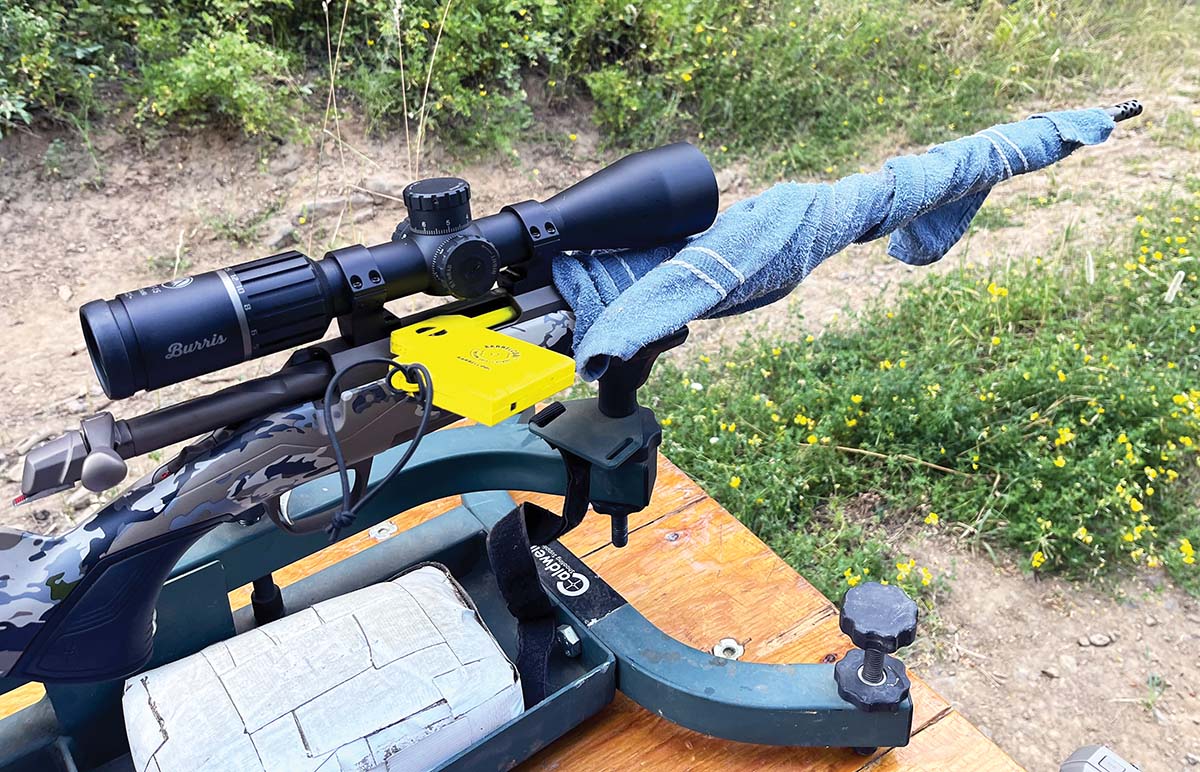
The thin barrel of the Browning X-Bolt 2 Speed OVIX required cooling between each fired group, a BarrelCool barrel fan and wet towels wrapped around the barrel saving some time.
The 6.8 Western is based on a modified 270 Winchester Short Magnum (WSM) case (introduced in 2002), shortened to allow more magazine space when loaded with long-for-caliber bullets. This case shortening is also said to improve the ratio of velocity output to powder burned. The maximum pressure limit is 65,000 pounds per square inch (psi), just like the 270 WSM.
The 6.8 Western measures 1.583 inches from base to shoulder point, 1.743 inches to the shoulder/neck junction and 2.020 inches long overall. By comparison, the 270 WSM measures 1.664 inches from base to shoulder point (.080-inch longer), 1.823 inches to shoulder/neck junction (.08-inch longer) and 2.860 inches overall (.84-inch longer). This gives both cartridges a .2765-inch-long neck. The 6.8 Western holds about 74 grains of water when filled to the case mouth, the 270 WSM about 9 grains more. With this case-capacity advantage, the 270 WSM should prove superior, right? Not when you consider that the WSM cartridge was designed around a standard 270 Winchester 1:10 twist rate, meaning bullet selection essentially tops out at 150 grains.
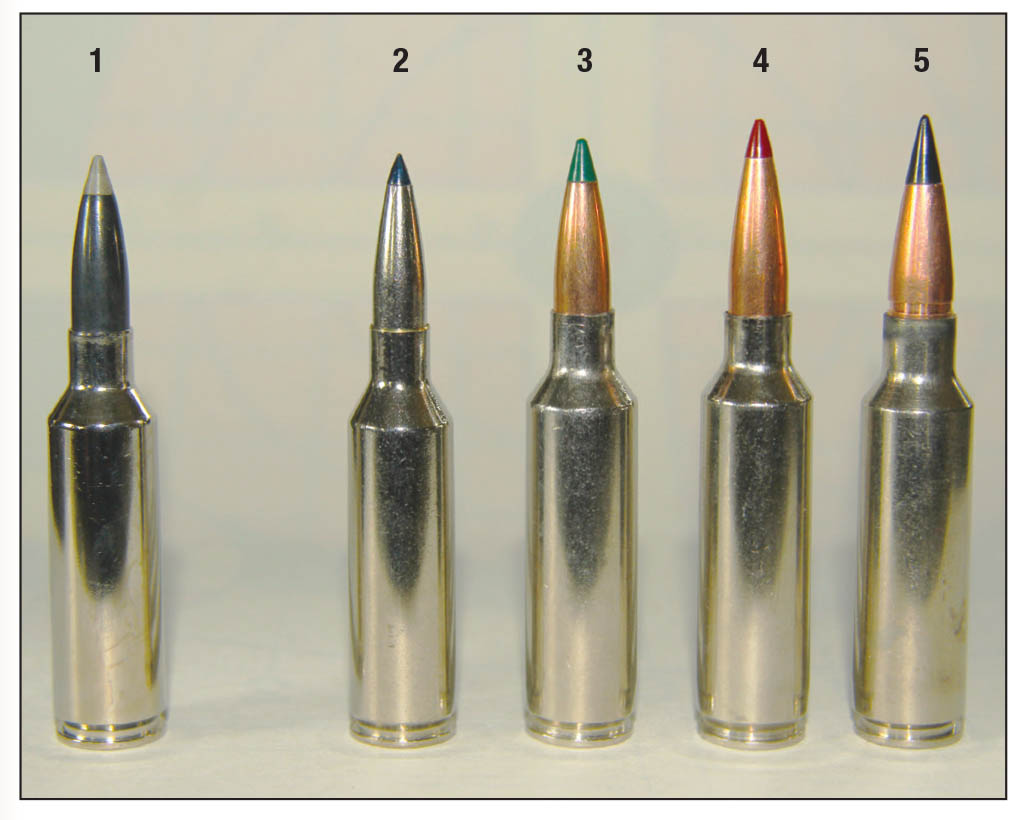
Shown for comparison: (1) 6.8 Western under discussion, (2) 6.5 PRC, (3) 270 Winchester Short Magnum (WSM), (4) 7mm WSM and (5) 300 WSM. The 6.8 Western was created by shortening the 270 WSM case.
Standard 270 Winchester bullets fall within the 130- to 150-grain range, while the 6.8 Western easily handles bullets weighing as much as 165 to 175 grains. Initial bullet options were produced by Sierra (175-grain Tipped GameKing/TGK) and Nosler (165-grain AccuBond). These long-for-caliber bullets include high sectional densities that not only boost BCs but also provide exceptional penetrating potential. This makes 6.8 Western ammunition adequate for elk and moose at reasonable ranges, and even brown bears with carefully placed shots with proper bullets. The cartridge design and the rifle’s twist rate help produce energy exceeding that provided by the 6.5 PRC, and even the 7mm Remington Magnum with like-weight bullets. At the same time, producing a touch less recoil than the latter.
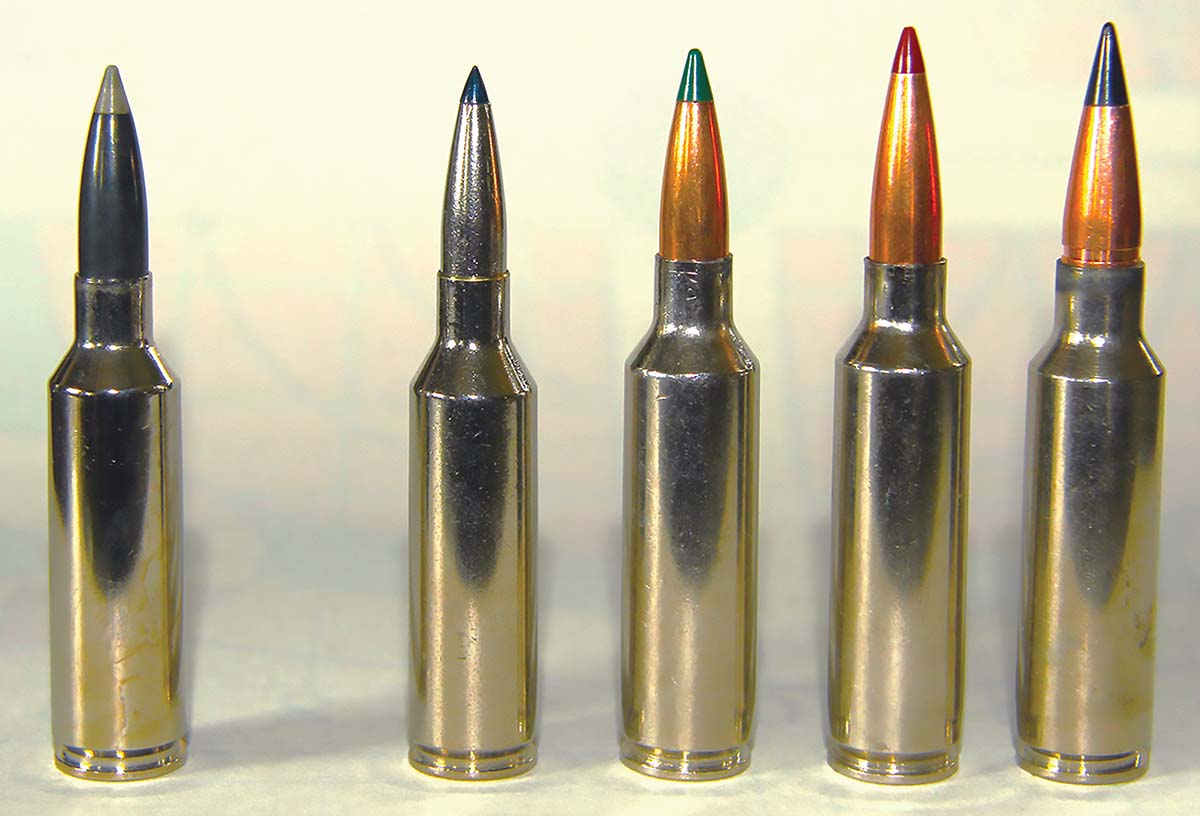
The 6.8 Western is one of many short and fat cartridges that have become popular with hunters and long-range shooters. The case design provides efficient powder ignition and high energy output from smaller doses of powder.
With same-weight bullets, the 6.5 PRC slightly outperforms the 6.8 Western. For instance, loaded with a streamlined 140-grain bullet, the PRC betters the 6.8 Western’s muzzle velocity by 100 feet per second (fps) and improves on 100-, 200- and 300-yard energy delivery by 184, 179 and 172 foot pounds (ft-lbs), respectively. Ten miles per hour wind drift is .3 inch to 1.8 inches less at 200 and 300 yards with the 6.5 PRC. That’s not what the 6.8 Western is all about.
Let’s compare the 6.5 PRC loaded with a 156-grain Berger EOL Elite Hunter bullet (the heaviest 6.5mm hunting bullet that I’m aware of) to a 6.8 Western loaded with a 175-grain Sierra TGK. Let’s give both a 2,850 fps muzzle velocity. The 6.5mm bullet includes a .679 G1/.347 G7 BC, the Sierra .633 G1/.315 G7. Regarding drop (100-yard zero) and wind drift (10 mph 90 degrees), the 100-, 200- and 300-yard numbers remain essentially equal. Regarding energy delivery, the 6.8 Western’s heavier bullet predictably improves on 6.5 PRC numbers by 284, 231 and 185 foot pounds at 100, 200 and 300 yards, respectively. Recall, too, the 6.5 PRC doesn’t quite fit in a true short action, which the 6.8 Western was specifically designed to do.
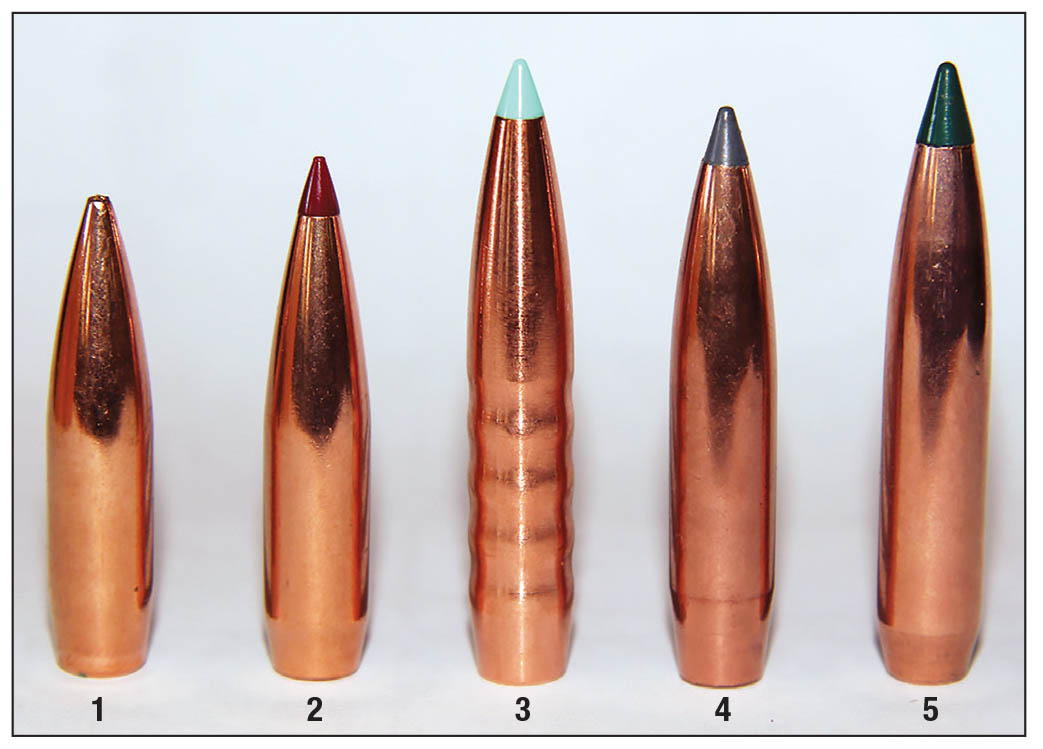
Bullets used to test the 6.8 Western included: (1) Berger’s 140-grain VLD Hunter, (2) Hornady’s 145-grain ELD-X, (3) Hammer Bullets’ 160-grain Hammer HHT, (4) Nosler’s 165-grain Long Range (LR) AccuBond and (5) Sierra’s 175-grain Tipped GameKing.
More telling, by increasing yardage to extremes, the merits of the 6.8 Western truly shine. Comparing the 6.5 PRC loaded with Nosler’s 142-grain LR AccuBond, the 6.8 Western with 165-grain LR AccuBond, 27 Nosler with the same bullet and 300 PRC with Hornady’s 212-grain ELD-X, these bullets drop to the subsonic threshold at 1,600, 1,650, 1,750 and 1,600 yards, respectively. Retained energy, in the same cartridge order, is 857, 980, 1,112 and 1,213 ft-lbs, respectively.
Understand that the reference to recoil doesn’t mean the 6.8 Western makes an ideal youth or petite woman’s cartridge. An 8-pound 6.8 Western rifle fed 165-grain bullets, leaving the muzzle at 2,975 fps, generates around 26 ft-lbs of recoil energy. A 6.5 PRC, given the same rifle weight and shooting a 140-grain bullet at 3,000 fps, produces about 19.5 ft-lbs of recoil energy, about 20 percent less. The 270 Winchester shooting 130-grain bullets essentially matches the 6.5 PRC’s recoil energy, while a 7mm Remington Magnum firing a 175-grain bullet generates about 27.5 ft-lbs of “kick,” or about 5 percent more than the 6.8 Western.
The 6.8 Western is chambered in select Winchester Model 70 and XPR rifle models, and most Browning rifle offerings, including the X-Bolt 2 Speed series. All hold 24-inch barrels. These are true short-action rifles handling a maximum cartridge length of 2.995 inches, which translates into faster cycling, lighter overall mass and a stiffer action. The 6.8 Western round helps these rifles bridge the gap between short-action portability and long-action performance. In .227-caliber terms, it neatly fills the gap between the 270 Winchester and fire-breathing 27 Nosler.
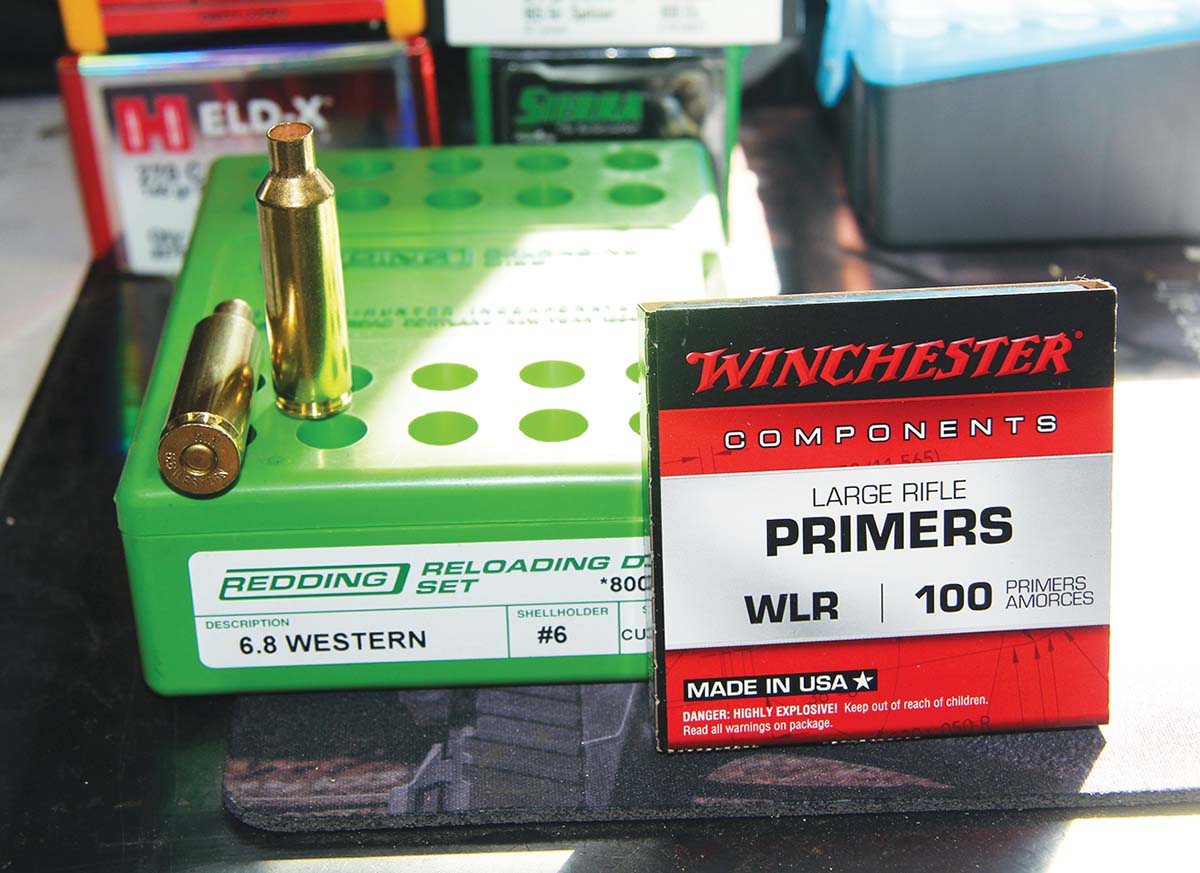
Components included in 6.8 Western testing included Redding Reloading Custom full-length dies, Winchester WLR primers and new Winchester WW brass.
Browning’s graceful new
X-Bolt 2 Speed OVIX bolt-action rifle served as the test vehicle. The OVIX designation references the high-contrast camouflage pattern used on this rifle’s
Vari-Tech composite stock, which also includes a new 1¼-inch-thick Inflex recoil pad. The Vari-Tech design allows streamlined length of pull and comb height adjustments as well as grip angle selection to create a custom fit and feel. The X-Bolt 2 Speed includes a redesigned receiver and bolt. The 24-inch sporter-weight barrel is fluted and holds a radial muzzle brake (Browning’s more aggressive
Recoil Hawg Sporter muzzle brake is available as an added option). The rifle’s odd M13x0.75 threads were not compatible with any of my suppressors or the adaptors on hand. Rifling twist is 1:7.5 inches. The action, barrel, alloy trigger guard (with Buck Mark engraving), and composite bottom metal received a durable CERAKOTE Smoked Bronze finish.
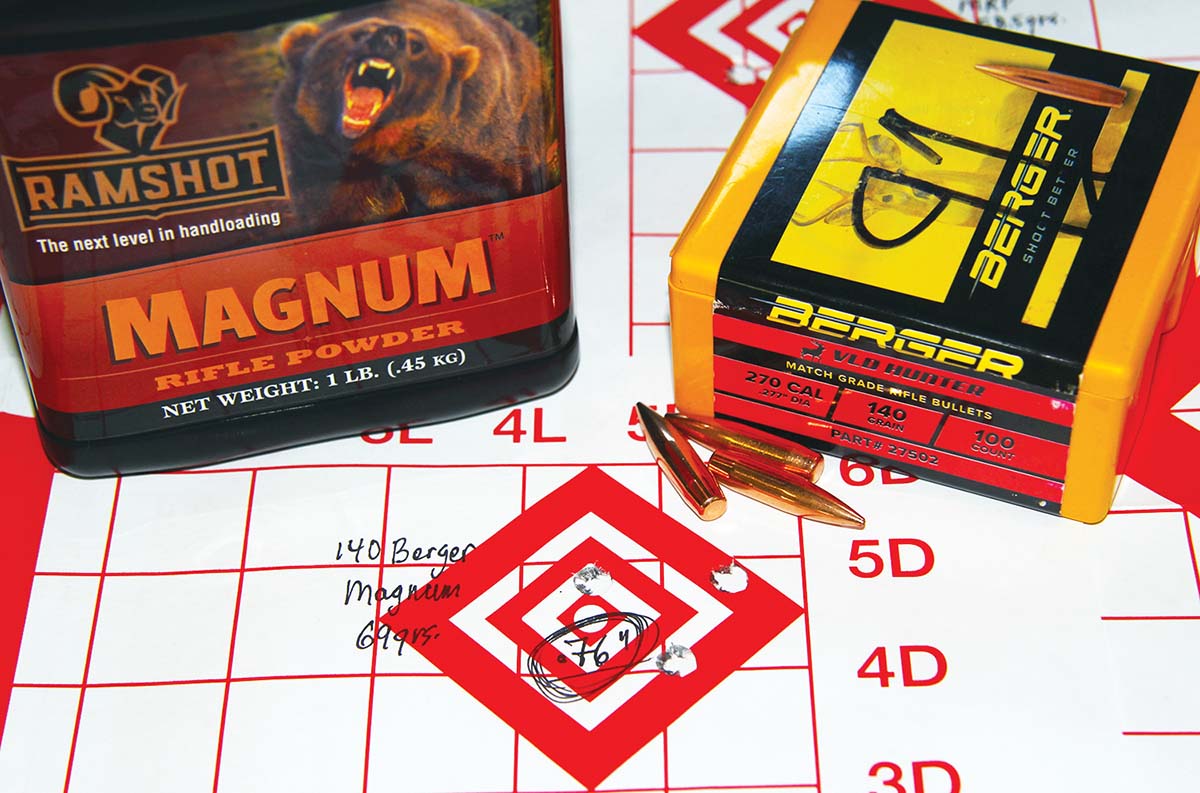
Berger’s 140-grain VLD Hunter shot well from the Browning X-Bolt 2 Speed OVIX. The best group measured .76 inch and sent at a scorching 3,209 fps using 69 grains of Ramshot Magnum.
The X-Bolt 2 Speed was designed for easy toting, including a 6-pound, 12-ounce out-of-the-box weight. Quite honestly, given the 6.8 Western’s magnum nature and summer heat, I’d hoped for a heavier rifle to absorb some recoil and a beefier barrel to slow warming. As shot, the rifle required cooling between each three-shot group, plugging in the
BarrelCool fan and wrapping the barrel in wet towels to help move things along.
The X-Bolt 2 Speed includes accuracy-enhancing details like a bedded action and free-floated barrel. Browning’s gold-plated DLX Trigger produces zero creep, take-up, or overtravel, while being adjustable down to 3 pounds. The rifle arrived from the factory with a 3.5-pound trigger pull, which I deemed good enough. The Vari-Tech stock adjustments are made internally, the comb on a dial, length of pull, including a spacer system and sporter or vertical grip modules supplied. It is all quite tidy and sleek, without the snags associated with many adjustable chassis systems. Rubber overmolding is found on all gripping surfaces, and the overall length is 44 inches. The detachable polymer magazine holds three rounds and features a base with a matching CERAKOTE finish. Additionally, matte-blued sling swivel studs are provided on both the front and rear. MSRP is $1,569.99. With a Burris RT-15 3-15x 50mm scope mounted in Browning’s slick medium-height/30mm X-Lock Scope Mounting System hardware, the final rifle weight was 8.62 pounds.
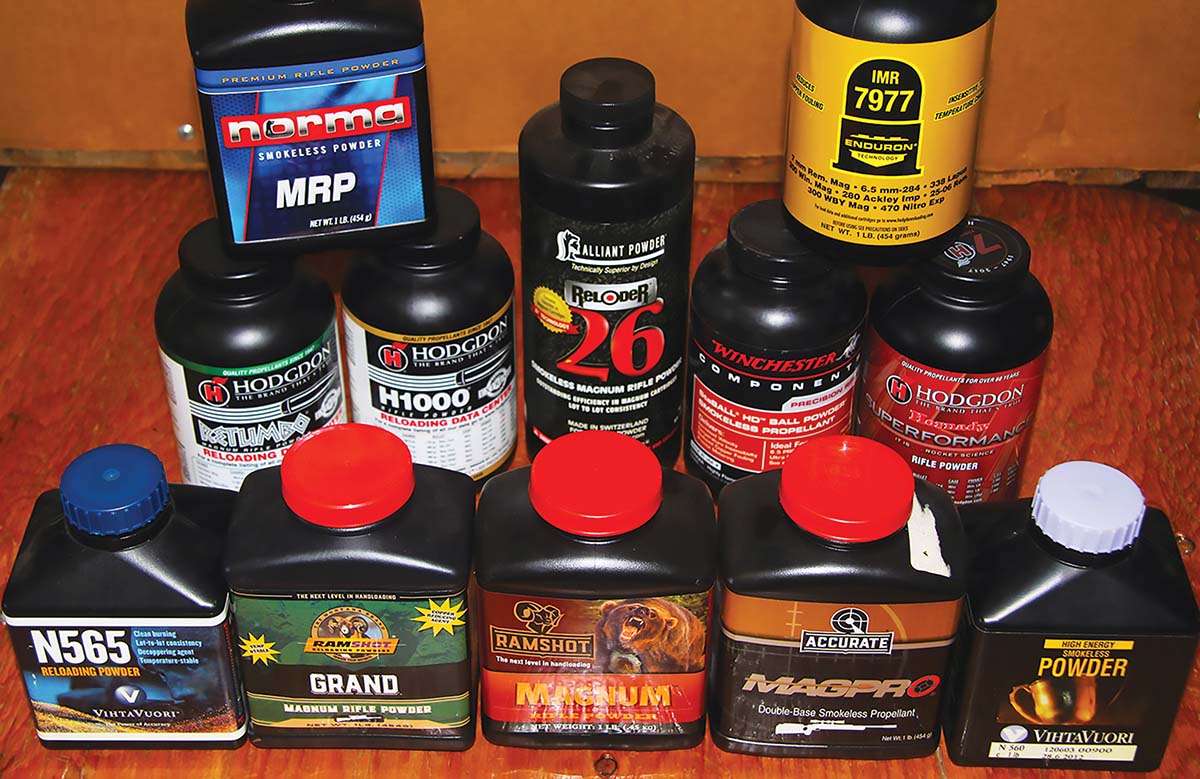
Patrick chose these powders to run the 6.8 Western through the paces: (top row) Norma MRP and IMR-7977; (middle row) Hodgdon Retumbo and H-1000, Alliant Reloder 26, Winchester StaBALL HD and Hodgdon Superformance; (front row) Vihtavuori N565, Ramshot Grand, Ramshot Magnum, Accurate Magpro and Vihtavuori N560.
The 6.8mm/.277-caliber component bullets I had on hand were generally too light to make the best of the 6.8 Western’s talents, which sent me shopping for heavier slugs. I was able to assemble Berger’s 140-grain VLD Hunting, Hornady’s 145-grain ELD-X, Hammer Bullets’ monolithic copper 160-grain HHT, Nosler’s 165-grain Long Range (LR) AccuBond and Sierra’s 175-grain Tipped MatchKing/TMG. That is a thorough representation of bullets suitable for everything from long-range pronghorn and Coues whitetail to elk and moose from the 6.8 Western.
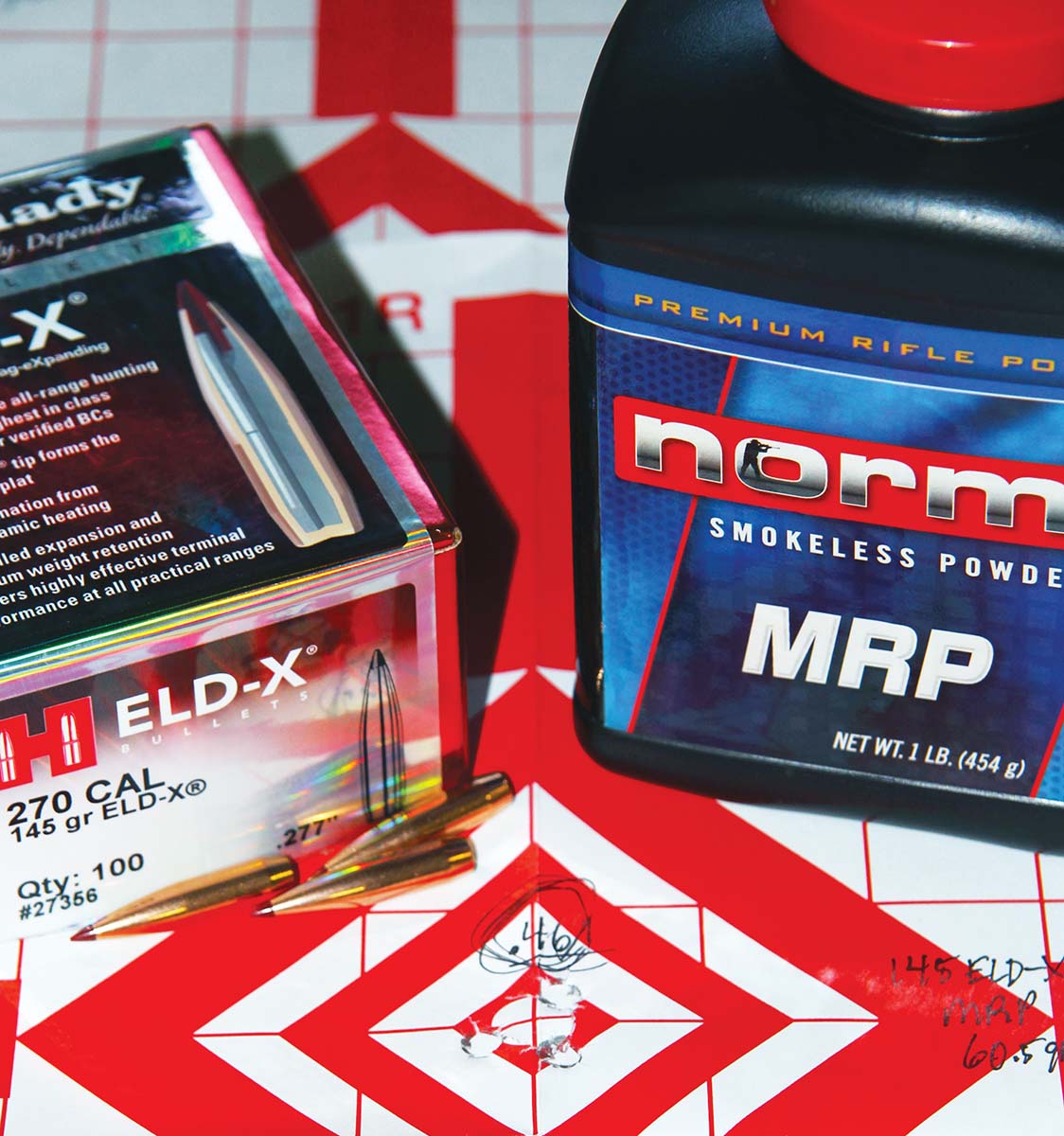
Hornady’s 145-grain ELD-X proved somewhat finicky, but produced the smallest group of the test. A charge of 60.5 grains of Norma MRP produced a .46-inch group at 3,042 fps and with a very low extreme velocity spread.
Winchester supplied new cases, and Winchester WLR primers were chosen for ignition. The online Hodgdon Reloading Data Center recommends magnum rifle primers for the 6.8 Western, while the
Lyman’s 51st Reloading Handbook lists Winchester WLR primers. WLR primers are, generally speaking, on the hotter side of “standard” options, as they were developed for Winchester ball powders. My advice would be to audition both after narrowing prospects in your rifle to determine if one provides a clear accuracy advantage.
As a relatively recent development, much of the load data available for the 6.8 Western includes modern powders with ultra-clean-burning, temperature-stable characteristics and some examples including copper-erasing technology. The 6.8 Western is compatible with powders ranging from, as examples, Ramshot Big Game, Winchester 760 and Accurate 2700 for light bullets, to Ramshot Grand, Hodgdon Retumbo and Winchester StaBALL HD for heavier bullets. Overall, the slow burners generally prove versatile enough to serve all bullet weights. Powders chosen to develop loads in this series included Norma MRP, Hodgdon Extreme Series H-1000, Superformance, and Retumbo; temperature-stable de-coppering powders were Winchester StaBALL HD, IMR-7977 Enduron and Ramshot Grand. Additionally, temperature-stable copper-erasing powders were Ramshot Magnum and Accurate Magpro, and Alliant Reloder 26, Vihtavuori N560 and N565.
All powder charges were thrown using a 4.3cc Lee Precision Powder Measure scoop and finished with an RCBS trickler, while being weighed on a precise RCBS beam scale. All resizing and bullet seating was conducted using an Area 419 ZERO Reloading Press and Redding Reloading Custom Series full-length die set. Cases were squared and trimmed to match 1.664-inch specs and chamfered inside and out. Primers were seated using an RCBS Universal Hand Priming Tool.
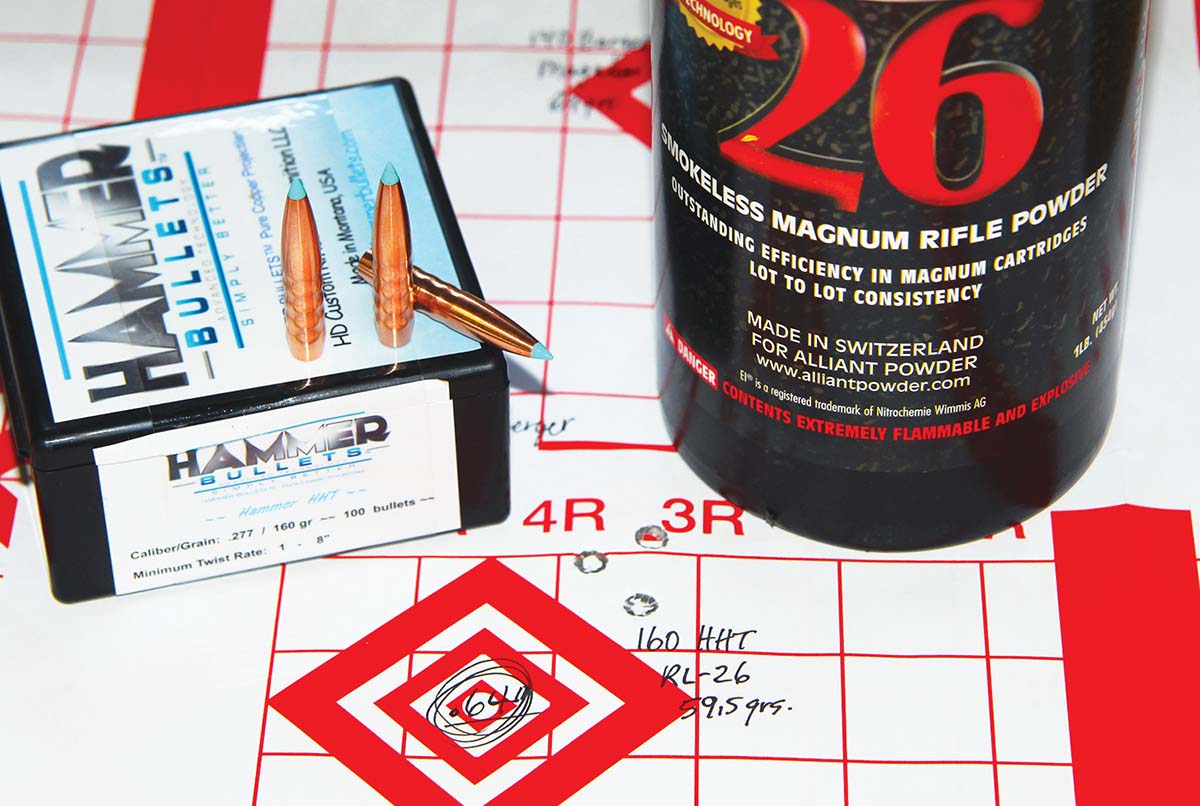
Proving the best combination with this bullet was the Hammer Bullets 160-grain HHT and 59.5 grains of Alliant – printing into .64-inch at 3,018 fps and producing a very low extreme velocity spread.
Of particular note is the limited freebore in the 6.8 Western chamber compared to cartridges such as the 6.5 PRC. When loading the long, heavy bullets for which it was designed, the overall cartridge length must be restricted to fit short-action magazines. This typically requires seating the bullet deep enough that the boat-tail extends past the neck-shoulder junction, intruding on powder capacity. If a bullet is seated long and single fed, it will soon contact or jam into the rifling; in testing, cartridges much beyond 2.920 inches would not chamber. The 160-grain Hammer HHT, for example, was the longest bullet tested that would chamber at 2.910 inches.
On the other hand, lighter projectiles such as the 140-grain Berger VLD Hunting and 145-grain Hornady ELD-X allow higher velocities and flatter trajectories at reasonable ranges. Even the 140-grain Berger VLD Hunting, with a G1 ballistic coefficient of .504, demonstrated excellent long-range performance. (See the accompanying Ballistic Chart for a full comparison of tested loads.)
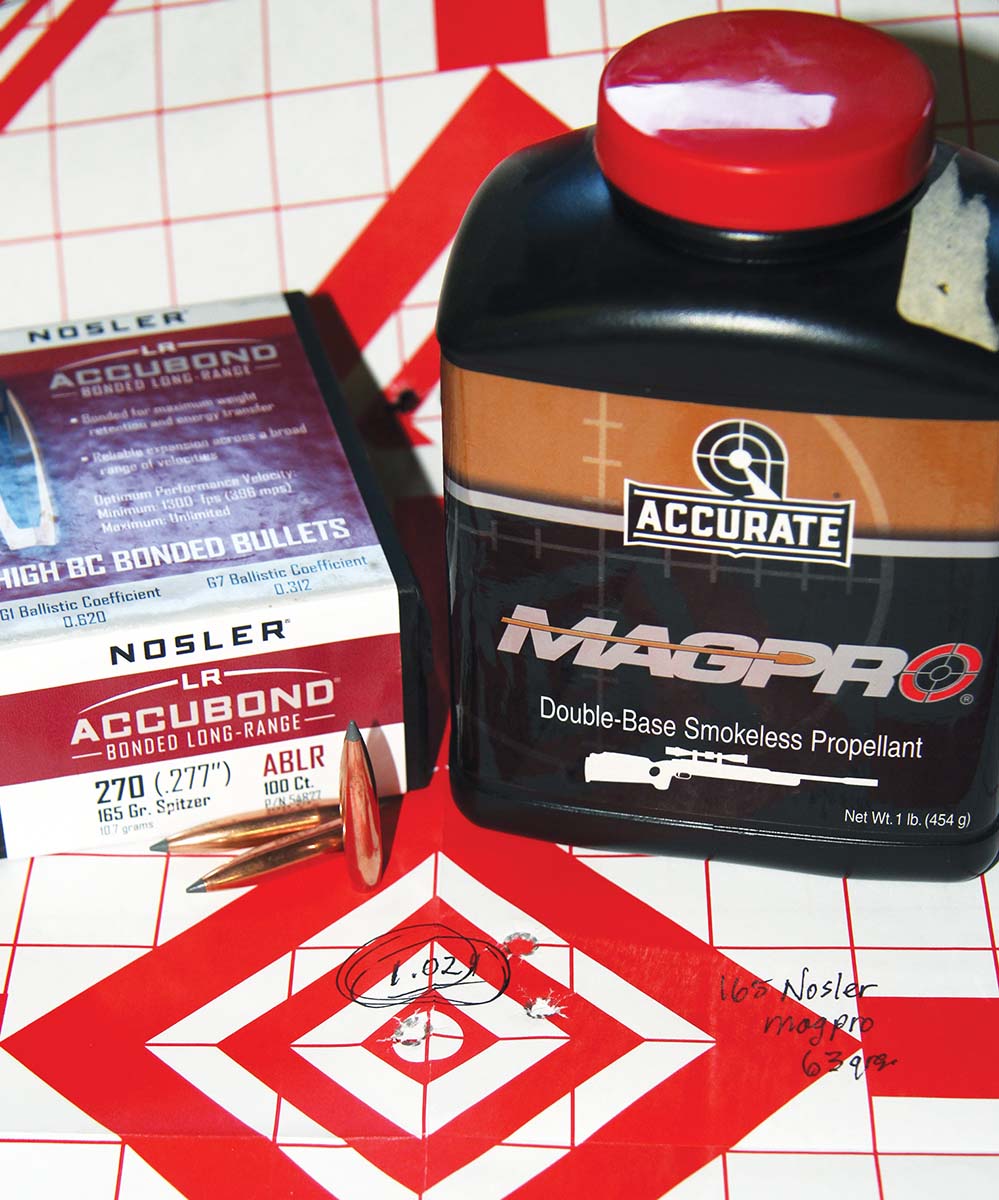
Nosler’s 165-grain Long Range (LR) AccuBond struggled with the powders chosen, the best group measuring just 1.02 inches using 63 grains of Accurate Magpro. Muzzle velocity was 2,892 fps.
In factory ammunition, overall lengths included 2.838 inches for Winchester’s 170-grain Ballistic Silvertip load, 2.880 inches for their Expedition Big Game Long Range 165-grain LR AccuBond load, and 2.905 inches for Winchester’s 170-grain Power Point and Browning’s Long-Range Pro 175-grain Sierra Tipped GameKing loads.
I’m a little embarrassed to admit that I hadn’t really given the 6.8 Western much thought before conducting this test. Now that I am aware of the round’s design logic and have seen the results firsthand, I have to say I’m impressed. For the big game hunter looking for a single rifle to do it all, the 6.8 Western would be pretty difficult to beat. Need a long-range pronghorn and plains deer round? Load streamlined 140- to 145-grain bullets for laser-like trajectory and lightning-strike impacts. Need a potent elk round that will hit with authority out to 500 yards? Load a 160-plus-grain all-copper slug or 165-grain controlled-expansion option. Considering a trip to Alaska or Canada to see moose? The 6.8 Western will handle that as well, loaded with a hard-hitting 175-grain bullet with deep-boring sectional density. If an unexpected encounter with a brown bear were to arise, I’d also feel pretty confident with that 175-grain slug as backup.











.jpg)
.jpg)


